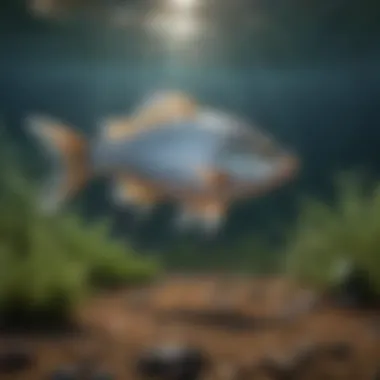Optimal Fishing Times in Texas: A Comprehensive Guide


Intro
Fishing is a popular pastime in Texas, attracting both locals and visitors alike. Understanding the best times to fish can make a significant difference in one's success. There are many factors that influence when fish are most active, such as time of day, season, and environmental conditions. This article will delve into these aspects, offering practical insights for anglers of all experience levels.
Fascinating Facts About Fish Species
Unique Characteristics
Texas is home to diverse fish species, including Bass, Catfish, and Trout. Each species has its own unique characteristics. For instance, Largemouth Bass can grow to over 20 inches long and are known for their aggressive nature. On the other hand, Catfish have a keen sense of smell, which enables them to locate food from far distances. This adaptability is crucial for survival in varying habitats across Texas.
Extraordinary Abilities
Fish have developed extraordinary abilities that aid in both hunting and evasion. Some species, like the Texas native Red Drum, are capable of detecting vibrations in the water, helping them locate prey. Additionally, many fish possess specialized coloration and patterns, functioning as camouflage or signaling to others during mating seasons. These abilities play a critical role in fish behavior, especially during feeding times.
Behavior and Habitat
Natural Habitats
Fish inhabit a range of environments, from the clear lakes in Central Texas to coastal waters in the Gulf of Mexico. Understanding these habitats is crucial for anglers. The availability of food sources and the ecological balance of these environments dictate fish activity. Specific times, such as dawn and dusk, tend to be more favorable due to increased predator activity.
Social Structures
Fish often exhibit complex social structures. Schools are common, especially in species like Shad, which often create large groups for protection against predators. Knowledge of these behaviors can enhance fishing strategies. Fishing during times when fish are schooling typically leads to greater success.
Seasonal Variations
The Texas climate plays a significant role in fishing success. Spring brings warmer water, activating many species as they prepare for spawning. Summer can lead to deeper fish, as water temperatures rise. In fall, fish move back to shallower waters, making it a prime time for anglers. Winter fishing may require specific techniques, as fish become less active.
Closure
Understanding the intricate details of fish behavior, seasonal changes, and habitat influences is essential for maximizing fishing experiences in Texas. Tailoring fishing trips to align with these factors will increase chances of success, allowing anglers to enjoy this age-old pastime fully.
Understanding Texas Fishing Dynamics
Understanding the fishing dynamics of Texas is crucial for both experienced anglers and novices alike. The state's diverse geography and varying climatic conditions significantly affect fish behavior and, hence, fishing success. An informed approach to fishing in Texas ensures that fishermen can optimize their time and effort while maximizing their catch.
Benefits of Understanding Texas Fishing Dynamics
- Improved Success Rates: Knowing the specific factors influencing fish behavior, such as time of day and seasonal changes, can lead to higher success rates during fishing expeditions.
- Resource Optimization: Anglers can plan more efficiently, choosing the right locations and times to fish based on the geographical and climatic information available.
- Enhanced Experience: Understanding the environment not only aids in catching fish but also enriches the overall fishing experience.
Fishing in Texas is not merely an activity; it is an experience influenced by many elements, including geography and water bodies.
Geography and Climate of Texas
Texas is the second-largest state in the U.S., which results in an array of fishing environments. Mountains, plains, and coastlines each provide unique habitats for various fish species.
- Diverse Ecosystems: The state's geography supports a broad spectrum of ecosystems, from the freshwater lakes in the east to the coastal waters of the Gulf of Mexico.
- Climate Variations: The climate in Texas ranges from humid subtropical in the east to arid in the west. These variations can affect fish activity profoundly.
Fish typically respond to changing weather patterns. For example, the arrival of a cold front may trigger increased feeding activity among fish. Understanding these conditions allows anglers to choose their fishing times more wisely.


The Role of Water Bodies
Water bodies are the lifeblood of fishing in Texas. Rivers, lakes, and coastal areas create diverse habitats for fish, each with its characteristics.
- Lakes and Reservoirs: Texas is home to numerous lakes and reservoirs, such as Lake Texoma and the Toledo Bend Reservoir. These locations are excellent for species like bass and catfish. The structure of the underwater environment, including submerged vegetation and rocks, plays a vital role in determining fish behavior.
- Rivers and Streams: Texas has many rivers, including the Rio Grande and the Guadalupe River. These rivers often have different flows and temperatures, creating distinct environments suitable for varying fish species.
- Coastal Waters: The Gulf Coast offers unique opportunities for saltwater fishing. Here, factors like tides and salinity can impact fish availability. Understanding water salinity levels can help fishers predict fish movement and behavior.
In summary, the geography and water bodies of Texas are central to its fishing dynamics. Anglers equipped with this knowledge can significantly enhance their fishing outcomes.
Seasonal Variations in Fishing
Understanding the seasonal variations in fishing is essential for both novice and experienced anglers. Each season brings unique conditions that can significantly affect fish behavior and availability. Recognizing these variations helps fishers plan their trips more effectively, ensuring they target the right species during their active periods. Seasonality affects water temperature, food availability, and fish spawning patterns, all of which can influence their feeding habits and habitat preferences.
Spring Fishing Strategies
Spring is a crucial time for fishing in Texas. As temperatures rise and daylight increases, fish become more active after the colder months. During this period, species such as bass and crappie begin their spawning activities, making them easier to catch.
- Optimal Locations: Closer to shorelines and shallow waters where fish spawn.
- Bait Selection: Use lively baits like shad or worms since fish are more aggressive during this time.
- Weather Patterns: Look for stable weather conditions. A rise in temperature often triggers fish movement.
Timing your fishing trips to coincide with warm fronts can enhance success. Early mornings and late afternoons are particularly productive, as fish tend to feed more actively.
Summer Fishing Opportunities
Summer presents both challenges and opportunities. High temperatures can lead to changes in fish behavior. Fish tend to seek cooler depths during the heat of the day. Early mornings and late evenings remain the best times to fish.
- Target Species: Largemouth bass and catfish often respond well to night fishing.
- Techniques: Utilizing topwater lures at dawn and dusk can be effective, while using deeper-diving baits during midday.
- Water Bodies: Concentrate on shaded areas near docks or vegetation, where fish escape the heat.
Proper hydration and sun protection are crucial during summer outings. Understanding how fish react to heat can greatly improve your fishing results.
Fall Fishing Insights
As summer fades into fall, water temperatures begin to drop, influencing fish behaviors once again. Fish fatten up for the coming winter, making this season prime for catching species like trout and panfish.
- Movement Patterns: Fish often move to shallower waters to feed in preparation for colder months.
- Bait Techniques: Use slow, steady retrievals with natural baits or jigs to mimic the action of dying prey.
- Seasonal Changes: Take notice of the changing leaves and cooling temperatures, as these can indicate when fish are becoming more active.
Overall, fall fishing can yield substantial rewards due to increased fish activity as they prepare for winter.
Winter Fishing Techniques
Winter fishing presents a unique set of challenges due to cold temperatures and often unpredictable weather conditions. Fish become less active, but they still need to feed, and knowing where to find them is crucial.
- Ice Fishing: In regions where ice forms, use tip-ups and jigging techniques to reach fish beneath the ice.
- Lure Selection: Smaller baits are often more effective, as fish tend to be less aggressive.
- Best Times: Midday is usually the most fruitful time when water temperatures are slightly warmer.
Being adaptable and prepared for rapidly changing weather conditions is vital during winter fishing trips.
Seasonality profoundly affects fishing strategies. Always adapt your techniques to the current environmental conditions and fish behaviors.
Understanding these seasonal variations is key for any fisher who wishes to be successful in Texas' diverse waters. Adjustments based on season can drastically improve one’s fishing success.
Time of Day Considerations
Fishing success is often tied to the times of day when fish are most active. Understanding how various factors affect fish behavior during different parts of the day can lead to more fruitful fishing trips. This consideration is critical as fishes have distinct feeding and activity patterns that align with natural light, temperature variations, and other environmental influences.


Early Morning Insights
The early morning hours are often viewed as prime fishing time. As night transitions to day, fish begin to stir from their nocturnal shelter. This period is marked by reduced light and cooler temperatures, creating optimal conditions for both predators and prey.
Key considerations during this time include:
- Temperature: The water temperature can be cooler, which often makes fish more active.
- Light Levels: Dimming light can help angler approach quietly.
- Feeding Behavior: Many species, such as bass and trout, tend to feed aggressively after dawn.
The early morning provides a unique opportunity to catch species that are often less active during the heat of the day.
Midday Fishing Factors
As the sun rises higher, conditions for fishing can change dramatically. Midday can be less predictable due to increased temperatures and harsh sunlight. Fish may retreat to deeper waters or shaded areas of vegetation, making them harder to catch. However, strategies for midday fishing exist:
- Downsizing Bait: Lighter and smaller offerings may entice wary fish.
- Presenting in Shade: Look for areas with shadows or cover, such as docks or submerged structures.
- Adjusting Fishing Techniques: Switching to slower, more methodical approaches can draw fish out.
Evening Opportunities
As daylight fades, evening hours can also prove beneficial for fishing. Similar to the early morning, many fish species become more active again. The temperature drops, and light fluctuations trigger a feeding frenzy in some species. Key aspects to consider during evening fishing include:
- Pre-Dusk Activity: Fish often feed heavily in anticipation of the darkness to come.
- Bait Choices: Larger and more vibrant lures tend to work well in low light.
- Setting Up For Night Fishing: Prepare for extended pursuits as some anglers opt for night fishing, targeting nocturnal feeders.
Overall, understanding the key times of day when fish are active is essential. Planning fishing trips around these insights increases the likelihood of successful catches.
Species-Specific Fishing Times
Understanding the specific times that various fish species are most active is crucial for successful fishing in Texas. Each species has unique behaviors, feeding patterns, and habitat preferences. Knowledge of these aspects can enhance the fishing experience and improve catch rates. Additionally, time-specific fishing can provide insights into conservation practices and increase awareness regarding local fish populations.
Bass Fishing in Texas
Bass fishing is popular among anglers in Texas due to the abundance of species like largemouth and smallmouth bass. These fish are most active at dawn and dusk, periods often referred to as the **
Environmental Factors Affecting Fishing
Understanding the environmental factors affecting fishing in Texas is crucial for maximizing success on any fishing trip. These aspects can significantly influence fish behavior, making them more or less likely to bite. By grasping these elements, an angler can select the best times and methods to ensure a fruitful outing. Each factor interacts in complex ways, so awareness and preparation enhance the overall fishing experience.
Weather Impact on Fishing
Weather conditions play a critical role in fishing dynamics. Fish are sensitive to changes in the atmosphere and can alter their feeding habits based on weather patterns.
Key Weather Elements:
- Cold Fronts: Typically, when a cold front passes, fish become less active and may retreat to deeper water.
- Rain: Overcast days often lead to increased fish activity, as the lack of sunlight makes them feel safer and more prone to feeding.
- Humidity and Wind: Moderate to high humidity levels can promote good fishing, while strong winds may create challenges for casting and affecting fish movement.
Fishing just before or after weather changes can bring high rewards. Consider planning your trips around predicted weather shifts for the best results.
Water Temperature Considerations
Water temperature is a definitive factor in the behavior of fish. Each species has its preferred temperature range for optimal feeding and reproduction, thus affecting the times when they might be actively seeking food.
General Temperature Ranges:


- Cold-Water Species: Trout and some bass species typically thrive in cooler waters, preferring temperatures from 55 to 65°F.
- Warm-Water Species: Species like catfish and sunfish enjoy warmer waters, usually at temperatures of 70°F and above.
Fish metabolism speeds up in warmer waters, leading to increased activity levels. Therefore, monitoring local water temperatures can provide insights into when to fish effectively.
Moon Phases and Fish Behavior
The lunar cycle can influence fish activity and feeding patterns. Understanding the relationship between moon phases and fish behavior can greatly enhance fishing success.
Lunar Effects:
- New Moon and Full Moon: These phases typically create stronger tides. Fish tend to feed more actively during these times, especially during dawn and dusk.
- Quarter Moons: Activity often decreases during the half moon phases, making fishing less predictable.
"Planning your fishing trip around moon phases can yield surprising results and optimize your chances of catching more fish."
Recognizing these natural rhythms allows anglers to align their efforts with fish behavior, significantly increasing the likelihood of a successful catch.
Techniques to Optimize Fishing Success
Fishing in Texas can be a rewarding activity, but it requires careful planning and knowledge of various techniques to maximize success. Understanding the factors that influence fish behavior is essential for any angler. Various techniques can help you not only catch fish but also enhance the overall fishing experience. In this section, we will dive into critical strategies, focusing on bait usage, gear selection, and local regulations.
Using Bait Effectively
Choosing the right bait can significantly influence your catch rates. Different fish species have particular preferences based on their diet and the time of year. For example, bass are often attracted to worms, lures, and jigs, particularly during their spawning season. Catfish, on the other hand, might be more tempted by stink baits or live bait like shrimp and minnows.
When selecting your bait, consider the following elements:
- Species-Specific Preferences: Know what type of bait works best for the fish you are targeting.
- Seasonal Changes: Some baits are more effective at certain times of the year when fish behavior shifts.
- Water Conditions: The effectiveness of bait can vary with water temperature and clarity.
- Local Knowledge: Engage with local anglers or online forums to understand what bait has been successful in specific water bodies.
Epilogue
The exploration of optimal fishing times in Texas reveals multiple layers of understanding that are essential for anglers. It is not just about casting a line; it requires strategic planning based on various elements like species behavior, environmental conditions, and seasonal changes. By recognizing these factors, fishers can significantly enhance their chances of success in their fishing endeavors.
A thorough analysis of best practices allows anglers to make informed decisions. This includes understanding the most successful times to fish based on specific species, as well as adapting techniques that align with changing conditions. Time management becomes critical here; knowing when to fish during the day and season allows for maximized productivity.
Benefits of Knowledge: Awareness of the local climate, the influence of moon phases, and water temperature leads to better outcomes. Not only can it improve individual success rates, but it also fosters a deeper connection with the natural environment.
Recap of Best Practices
When you plan a fishing trip in Texas, keep in mind the following:
- Seasonal Patterns: Each season holds unique opportunities and challenges.
- Daily Timing: Optimal fishing often occurs during key times of the day.
- Species Behavior: Know the habits of the species you target.
- Spring is typically dynamic with spawning activity.
- Summer fishing requires different strategies due to higher temperatures.
- Fall offers great opportunities as fish feed before winter.
- Winter calls for patience and specialized techniques.
- Early mornings and late evenings tend to yield better catch rates.
- Midday sessions can be less fruitful, requiring adaptation.
- Bass, catfish, and trout each have specific times when they are most active.
In addition to these points, understanding local regulations is also a best practice. This ensures that all fishing is conducted legally and sustainably, enhancing the experience for current and future anglers.
Future Considerations for Fishers
As fishing practices evolve, there are several considerations for the future.
- Sustainability Efforts: Awareness around conservation needs to increase. Anglers should practice catch and release and remain informed on local regulations that support ecological health.
- Technology Integration: Tools such as fishing apps and sonar devices can greatly aid in determining optimal fishing times. Staying updated with technology can enhance success.
- Community Engagement: Joining local fishing groups or forums on platforms like Reddit can facilitate shared knowledge and experiences. Knowledge gained from collective experiences can significantly benefit individual practices.
Ultimately, the journey of fishing in Texas can be deeply rewarding. Understanding the nuances of optimal fishing times, while considering environmental and social factors, ensures a fulfilling and responsible angling experience.







